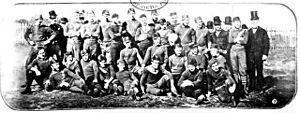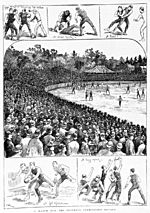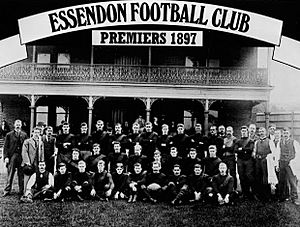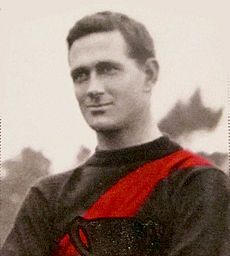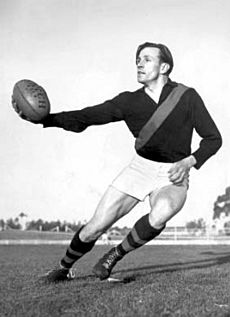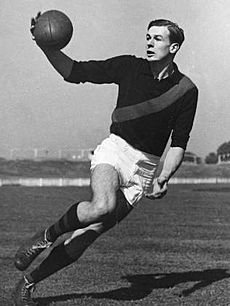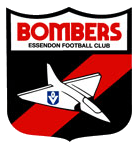Essendon Football Club facts for kids
Quick facts for kids Essendon Football Club |
||||
|---|---|---|---|---|
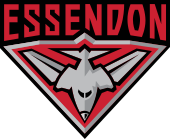 |
||||
| Names | ||||
| Full name | Essendon Football Club | |||
| Nickname(s) |
|
|||
| Motto | Suaviter in Modo, Fortiter in Re "Gently in manner, resolutely in execution" |
|||
| 2024 season | ||||
| Home-and-away season | 14th | |||
| Leading goalkicker | Kyle Langford (43 goals) | |||
| Club details | ||||
| Founded | 1872 | |||
| Colours | Red Black | |||
| Competition | AFL: Senior men AFLW: Senior women VFL: Reserves men VFLW: Reserves women VWFL: Wheelchair |
|||
| President | David Barham | |||
| CEO | Craig Vozzo | |||
| Coach | AFL: Brad Scott AFLW: Natalie Wood VFL: Cameron Joyce VFLW: Cherie O'Neill |
|||
| Captain(s) | AFL: Zach Merrett AFLW: Stephanie Cain/Bonnie Toogood VFL: Xavier O'Neill VFLW: El Chaston VWFL: Louis Rowe |
|||
| Premierships | VFL/AFL (16)
|
|||
| Ground(s) | AFL: Docklands Stadium (56,347) & Melbourne Cricket Ground (100,024) AFLW: Windy Hill (10,000) VFL/VFLW: Windy Hill (10,000), The Hangar (3,500) VWFL: Boroondara Sports Complex |
|||
| Former ground(s) | East Melbourne Cricket Ground (1897–1921) | |||
| Windy Hill (1922–91) | ||||
| Training ground(s) | The Hangar (2013–) | |||
| Uniforms | ||||
|
||||
| Other information | ||||
| Official website | essendonfc.com.au | |||
The Essendon Football Club, often called the Bombers or Dons, is a professional Australian rules football team. They play in the Australian Football League (AFL), which is the top competition for the sport. The club started in 1872, founded by the McCracken family in their home in Ascot Vale. They took their name from the local area, the borough of Essendon.
Essendon played its first recorded game on June 7, 1873. From 1878 to 1896, they were part of the Victorian Football Association (VFA). In October 1896, Essendon joined seven other clubs to create the Victorian Football League (VFL). This league is now known as the Australian Football League (AFL) since 1990.
The club's main base was at the Essendon Recreation Ground, also known as Windy Hill, from 1922 to 2013. In late 2013, they moved to The Hangar in Tullamarine, on land near the Melbourne Airport. Essendon plays its home games at both Docklands Stadium and the Melbourne Cricket Ground. Zach Merrett is the current captain of the club.
Essendon is one of Australia's most famous and successful football clubs. They have won 16 VFL/AFL premierships. This is the most wins by any club, shared with Carlton and Collingwood. They also won four VFA premierships in a row from 1891 to 1894, a record in that league. Essendon is also the only club to win a premiership in its very first season (1897). However, they have not won a premiership since 2000, and their last finals win was in 2004.
Three Essendon players—John Coleman, Bill Hutchison, and Dick Reynolds—are considered "Legends" in the Australian Football Hall of Fame. Their coach, Kevin Sheedy, is also a Legend.
Essendon also has reserve teams for men and women in the Victoria Football League and VFL Women's. Since 2022, they have a senior women's team in the national AFL Women's competition.
Contents
- Club History
- Club Symbols
- Membership
- Club Rivalries
- Club Achievements
- Current Squad
- Match Records
- Reserves Team
- Women's Teams
- Club Activism
- See also
Club History
Early Years (1871–1896)
The Essendon Football Club was formed in 1872. It is believed to have started at a meeting in the home of the McCracken family, who were well-known brewers. Their property in Ascot Vale was where a team of local junior players practiced.
Robert McCracken (1813–1885) was the club's founder and first president. His son, Alex McCracken, was the first secretary. Alex later became president of the new VFL. Alex's cousin, Collier McCracken, who had played for Melbourne, was Essendon's first captain.
The club played its first recorded game on June 7, 1873, against the Carlton Second Twenty (their reserve team). Essendon won by one goal. In their first season, Essendon played 13 matches, winning seven, drawing four, and losing two. They joined the Victorian Football Association (VFA) as a junior club in 1877. They became a senior club in the 1878 season. In their early VFA years, Essendon played home games at Flemington Hill. They moved to the East Melbourne Cricket Ground in 1881.
In 1878, Essendon played its first game on a full-sized field at Flemington Hill. In 1879, they played Melbourne in one of the earliest night matches, using a white ball. In 1883, the team played four matches in eight days in Adelaide.
In 1891, Essendon won their first VFA premiership. They won again in 1892, 1893, and 1894. Albert Thurgood, one of the club's greatest players, started playing in 1892. Essendon was undefeated in the 1893 season, with 18 wins and 2 draws.
Joining the VFL (1897–1915)
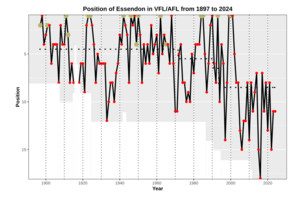
After the 1896 season, Essendon and seven other clubs formed the Victorian Football League. Essendon's first VFL game was in 1897 against Geelong. Essendon won its first VFL premiership by winning the 1897 VFL finals series in a special round-robin event. They won the premiership again in 1901, beating Collingwood in the Grand Final. The club won back-to-back premierships in 1911 and 1912, defeating Collingwood and South Melbourne.
The "Same Olds" Nickname
The club was known as "the Same Old Essendon" because of a song sung by their supporters. This nickname first appeared in newspapers in 1889 and was often shortened to "Same Olds."
In 1882, the club moved its home games to the East Melbourne Cricket Ground. This move was not popular with many Essendon fans. As a result, a new team called Essendon Town (later just Essendon A) was formed in 1900. This new team played in the VFA at the Essendon Cricket Ground.
Return to Essendon (1921–1932)
After the 1921 season, the East Melbourne Cricket Ground was closed. Essendon needed a new home ground. The Essendon City Council offered the team the Essendon Cricket Ground, promising to improve it.
The club wanted to move to North Melbourne, but the VFA stopped this. So, Essendon returned to its original area. The VFA Essendon club then broke up, and many of its players joined North Melbourne.
The nickname "Same Olds" was no longer used. By 1922, the team became known as "the Dons" (from EssenDON). Later, during World War II, they became known as "The Bombers" because Windy Hill was close to the Essendon Aerodrome.
In the 1922 season, Essendon played in Essendon again and reached the finals, finishing third. In the 1923 season, they finished first. Essendon then won the 1923 Grand Final against Fitzroy. This team was called the "Mosquito Fleet" because many players were small and very fast.
In the 1924 season, Essendon won another premiership. This was unique because there was no Grand Final that year. The top four teams played a round-robin, and Essendon won based on their overall performance. This meant Essendon won back-to-back premierships again. However, there were rumors of players taking bribes, which hurt the club's image. The team then had a tough period with poor results for the next decade.
The Dick Reynolds Era (1933–1960)
The 1933 season marked a turning point with the debut of Dick Reynolds. He is considered one of the greatest players ever. Reynolds won his first Brownlow Medal at age 19. He won three Brownlow Medals in total (1934, 1937, 1938).
Reynolds also became a great coach. He started coaching in 1939 while still playing. He led the team to the finals in 1940, their first time since 1926. The Essendon Football Club officially adopted the nickname The Bombers in April 1940.
In 1941, Essendon reached the Grand Final but lost to Melbourne. In 1942, Essendon finally won the premiership, beating Richmond.
After World War II, Essendon had a very successful period. In the five years after the war, they won three premierships (1946, 1949, 1950) and were runners-up twice. In 1946, Essendon was the strongest team, setting a Grand Final record score of 22.18 (150) against Melbourne.
In the 1947 Grand Final, Essendon lost by just one point to Carlton. In 1948, they drew the Grand Final with Melbourne but lost the replay.
The 1949 season saw the arrival of John Coleman, who many believe is Essendon's greatest player. In his first game, he kicked 12 goals. He kicked 100 goals for the season, helping Essendon win the premiership against Carlton by 73 points.
In 1950, Essendon was even stronger, winning back-to-back premierships by beating North Melbourne in the Grand Final. Coach Dick Reynolds was a star player in this game.
In 1951, Essendon aimed for a third straight flag. However, John Coleman was suspended, which hurt their chances. They still reached the Grand Final but lost to Geelong.
Coleman's career ended in 1954 when he injured his knee. He had kicked 537 goals in only 98 games. Without Coleman, Essendon struggled and did not win another premiership in the 1950s. They reached the Grand Final in 1957 and 1959 but lost both times to Melbourne.
After Reynolds: The "Slugging Seventies" (1961–1980)
John Coleman became Essendon's coach in 1961, taking over from Dick Reynolds. In 1962, Essendon had a great season, losing only two matches and finishing first. They easily beat Carlton in the 1962 Premiership. This was a big achievement for Coleman in only his second year as coach. They won another premiership in 1965, coming from fourth place on the ladder. Coleman had to step down in 1967 due to health issues and sadly passed away in 1973 at age 44.
After Coleman, the club faced tough times. They rarely made the finals and sometimes finished at the bottom of the ladder. They reached the 1968 VFL Grand Final but lost to Carlton by just three points. It would be 15 years before they played in another Grand Final.
From 1968 to 1980, Essendon had five different coaches. In the 1970s, Essendon teams were known for being tough. Players like Ron Andrews, Barry Davis, and Graham Moss were part of this era. In 1974, there was a famous half-time fight with Richmond at Windy Hill. In 1975, a game against Carlton led to many players being reported for fighting.
In 1980, new player Phil Carman was suspended for an incident with an umpire. Despite these challenges, the club recruited many talented young players in the late 1970s. These included Simon Madden, Tim Watson, Paul Van Der Haar, Terry Daniher, Neale Daniher, and Roger Merrett. These players would form the core of the successful Essendon teams of the 1980s.
A highlight during this period was Graham Moss winning the Brownlow Medal in 1976. He was the only Essendon player to win it for 40 years.
The Kevin Sheedy Era (1981–2007)
Former Richmond player Kevin Sheedy became head coach in 1981.
Essendon reached the Grand Final in 1983, their first since 1968, but lost to Hawthorn.
In 1984, Essendon won the pre-season competition and finished first in the regular season. They beat Hawthorn in the 1984 VFL Grand Final to win their 13th premiership, their first since 1965. The teams met again in the 1985 Grand Final, which Essendon also won. Essendon aimed for three flags in a row in 1986, but injuries to key players like Paul Van der Haar and Tim Watson affected their performance.
In 1988, Essendon improved, finishing sixth. In 1989, they finished second and beat Geelong in the Qualifying Final. However, they lost to Hawthorn and then Geelong in the finals.
In 1990, Essendon led for most of the season but lost to Collingwood in both the second semi-final and the Grand Final.
After the 1991 season, Essendon moved its home games from Windy Hill to the larger MCG. This led to more fans attending games and increased club income. The club's training and offices stayed at Windy Hill until 2013.
New young players like Gavin Wanganeen, Joe Misiti, Mark Mercuri, Michael Long, Dustin Fletcher, and James Hird joined the team. This group became known as the "Baby Bombers."
The team won the 1993 Grand Final against Carlton. That same year, Gavin Wanganeen won the Brownlow Medal, the first for Essendon since 1976. Three years later, James Hird also won the medal.
In 2000, the club started playing most of its home games at the new Docklands Stadium. The 2000 season was one of the most successful in VFL/AFL history. Essendon won 20 games in a row before losing one match. They then won their 16th premiership, beating Melbourne. This made it the most dominant single season in AFL/VFL history. Essendon also won the 2000 pre-season competition, meaning their only loss that year was to the Western Bulldogs.
Essendon was less successful after 2001. Many premiership players left or retired. The club remained competitive, reaching the second week of the finals in 2002, 2003, and 2004. Sheedy signed a new contract at the end of 2004.
In 2005, Essendon missed the finals for the first time since 1997. In 2006, they had their worst season since 1933, winning only three games. This was partly due to captain Matthew Lloyd suffering a season-ending injury. The club improved in 2007 but still missed the finals.
Recent Years (2008–Present)
Sheedy's contract ended after 2007, finishing his 27 years as Essendon coach. Matthew Knights took over for three seasons, reaching the finals once in 2009. Knights was dismissed as coach in August 2010.

On September 28, 2010, former captain James Hird became Essendon's new coach. In his first season, Essendon finished eighth. In 2012, they started strong but won only one more match in the second half of the season, missing the finals.
In 2013, the club moved its training and administration to The Hangar in Melbourne Airport. Essendon still uses Windy Hill for its reserves team's home games and for a social club.
Supplements Program and Penalties (2013–2016)
In 2013, the club faced an investigation regarding its 2012 player supplements program. An internal review found the program to be "experimental, inappropriate and inadequately vetted and controlled." On August 27, 2013, the club was found to have brought the game into disrepute. As a result, Essendon was fined A$2 million, lost early draft picks, and was removed from the 2013 finals series. Coach Hird was suspended for twelve months.
During Hird's suspension, assistant coach Mark Thompson coached the team in the 2014 season. He led them back to the finals, but they lost a close elimination final to North Melbourne. After the 2014 season, Thompson left for Hird to return.
In June 2014, 34 players were accused of using a banned substance during the program. On March 31, 2015, a tribunal found them not guilty. However, on January 12, 2016, the Court of Arbitration for Sport overturned this decision. It ruled that 34 past and present players had taken the banned substance. All 34 players were given two-year suspensions, though the actual time suspended was less due to previous provisional suspensions.
Because of these suspensions, Essendon played the 2016 AFL season with 12 of its regular senior players unavailable. The AFL allowed Essendon to sign additional players to cover these losses. Many thought the club would not win any games, but they managed to win three matches. The absence of experienced players allowed young players like Zach Merrett and Orazio Fantasia to shine. The club finished last on the ladder, receiving its first wooden spoon since 1933.
Post-Investigation (2017–2022)
Essendon settled its final financial payments related to the supplements issue in September 2017. They greatly improved in 2017, finishing 7th and making the finals, but lost to Sydney. The 2017 season also saw the retirement of club legends like Jobe Watson and James Kelly.
Expectations were high for the 2018 season after Essendon recruited Jake Stringer, Adam Saad, and Devon Smith. After a strong first round, their form dropped, and they lost many games. Coach Mark Neeld was sacked. The team's form improved later in the season, but they missed the finals.
Essendon acquired Dylan Shiel in 2018. In the 2019 season, they had inconsistent form but made the finals, finishing eighth. However, they lost to the West Coast Eagles by 55 points, extending their finals-winning drought to 15 years.
After 2019, assistant coach Ben Rutten was announced as John Worsfold's successor. 2020 was a disappointing year, with the Bombers finishing 13th and missing the finals. This marked 20 years since their last premiership.
In 2021, with Rutten as the sole coach, Essendon improved and returned to the finals, finishing eighth. They lost to the Western Bulldogs in the first elimination final.
Season 2022 was the club's 150th anniversary. Despite high hopes, the Bombers finished 15th. This poor performance led to Rutten being sacked. Brad Scott replaced him. Several board members also left their roles.
Brad Scott Era (2023–Present)
In 2023, there were reports that the club was thinking about changing its logo, but then-captain Zach Merrett denied these rumors.
At the end of the 2023 season, Matt Rosa joined Essendon as Talent & Operations Manager. Adrian Dodoro stepped back from his role as recruiting manager.
In Brad Scott's first season as coach (2023), Essendon was in fifth place after round 17 but finished 11th. In his second season (2024), Essendon finished with 11 wins, 1 draw, and 11 losses.
On August 13, 2024, club champion Dyson Heppell announced he would retire at the end of the season. Heppell played 253 games and was the last player from the group of 34 suspended players still at the club.
Club Symbols
Guernsey (Jumper)
Essendon's first recorded jumpers were navy blue. In 1877, a red sash was added over the left shoulder. This is why Essendon players are sometimes called "the men in the sash." The red sash helped Essendon players stand out from other teams who also wore blue.
Clash Jumpers
The AFL requires all clubs to have an alternative jumper for games where team colors might look too similar. From 2007 to 2011, Essendon's clash guernsey was mostly red with a wider sash. After 2011, the AFL decided this wasn't different enough.
From 2012 to 2016, Essendon's clash guernsey was mostly grey with a red sash outlined in black. The names of all Essendon premiership players were printed on the grey part.
Before the 2016 season, Essendon changed their clash guernsey to be mostly red with a black-outlined red sash. Premiership players' names were also printed on this jumper.
For the 2025 season, Essendon introduced a new away/clash guernsey. It is red with a black sash, which is the reverse of their home guernsey.
Yellow Armbands
In 2006, Essendon started a "Clash for Cancer" match with the Cancer Council of Victoria to raise money. Essendon players wanted to wear yellow armbands, but the AFL said no. The club wore them anyway and was fined $20,000. In 2007, the AFL allowed yellow armbands to be part of the jumper's sleeve. The 'Clash for Cancer' match is now an annual event.
Club Song
The club's theme song, "See the Bombers Fly Up," was written around 1959 by Kevin Andrews and Jeff Gamble. It uses the tune of "(Keep Your) Sunny Side Up" from 1929. The official version was recorded in 1972 and is still used today.
The song is played before every match and when the team wins.
- See the Bombers fly up, up!
- To win the preeemiership flag.
- Our boys who play this grand old game,
- Are always striving for glory and fame!
- See the Bombers fly up, up,
- The other teams they don't fear;
- They all try their best,
- But they can't get near,
- As the Bombers fly up!
Logo and Mascot
The club's current logo was introduced in 1998. It is the oldest AFL logo still in use.
Essendon's mascot is named "Skeeta Reynolds," after the famous player Dick Reynolds. Skeeta is a mosquito, chosen to honor the "Mosquito Fleet" team of the 1920s, which had many small, fast players. Skeeta is a red mosquito wearing an Essendon jumper and a red and black scarf.
Headquarters and Training
The Essendon Football Club's main training and administration base has been at The Hangar since 2013. Before that, it was at Windy Hill Oval from 1922 to 2013. Even earlier, their home ground was the East Melbourne Cricket Ground from 1882 to 1921.
Membership
Essendon has a large and loyal fan base. The number of club members has grown significantly over the years.
| Year | Total Members |
|---|---|
| 1984 | 10,231 |
| 1985 | 11,376 |
| 1986 | 12,607 |
| 1987 | 8,129 |
| 1988 | 8,432 |
| 1989 | 7,958 |
| 1990 | 11,046 |
| 1991 | 11,593 |
| 1992 | 10,034 |
| 1993 | 11,546 |
| 1994 | 19,720 |
| 1995 | 23,833 |
| 1996 | 24,324 |
| 1997 | 28,063 |
| 1998 | 27,099 |
| 1999 | 29,858 |
| 2000 | 34,278 |
| 2001 | 36,227 |
| 2002 | 35,219 |
| 2003 | 31,970 |
| 2004 | 33,469 |
| 2005 | 32,734 |
| 2006 | 32,511 |
| 2007 | 32,759 |
| 2008 | 41,947 |
| 2009 | 40,412 |
| 2010 | 40,589 |
| 2011 | 50,275 |
| 2012 | 47,708 |
| 2013 | 56,172 |
| 2014 | 60,714 |
| 2015 | 61,317 |
| 2016 | 57,494 |
| 2017 | 67,768 |
| 2018 | 79,319 |
| 2019 | 84,237 |
| 2020 | 66,686 |
| 2021 | 81,662 |
| 2022 | 86,001 |
| 2023 | 86,274 |
Club Rivalries
Essendon has strong rivalries with Carlton, Richmond, and Collingwood. These are four of the biggest and most supported clubs in Victoria. Games between them are often very close. Essendon also has a fierce rivalry with Hawthorn, which started in the 1980s. They also have a long-standing rivalry with the West Coast Eagles.
- Carlton – The rivalry between Essendon and Carlton is one of the strongest in the league. Both teams have won 16 premierships, so they are always competing to be the outright leader. They have played many important Grand Finals against each other.
- Collingwood – This rivalry grew from several Grand Final matches in the early VFL days. They met again in the 1990 Grand Final. Since 1995, the clubs play annually in the Anzac Day clash, which is the second biggest game of the season after the Grand Final.
- Richmond – This rivalry began with the 1942 Grand Final, which Essendon won. In 1974, a famous half-time fight happened at Windy Hill. The teams now play in the Dreamtime at the 'G match, which has made the rivalry even stronger.
- Hawthorn – Essendon and Hawthorn had many tough games in the mid-1980s when they were the top two teams. The rivalry became more intense after a big fight in a 2004 match, known as the Line in the Sand Match.
- North Melbourne – This rivalry goes back to 1896 when Essendon and other clubs left the VFA to form the VFL. North Melbourne wanted to join, but some believe Essendon blocked them. In 1950, the two teams met in their only Grand Final, which Essendon won. The rivalry became strong again in the late 1990s and early 2000s. In 1998, Essendon coach Kevin Sheedy famously called North executives "soft" to fire up his team.
- West Coast – This rivalry started three decades ago. In 1993, Essendon coach Kevin Sheedy famously waved his jacket after a close win against the Eagles. To this day, winning fans wave their jackets after games between these two teams. In 2004, James Hird kicked a match-winning goal with 35 seconds left and hugged a fan in the crowd.
Club Achievements
See Essendon Football Club honours.
Premierships
| Premierships | |||
| Competition | Level | Wins | Years Won |
|---|---|---|---|
| Australian Football League | Seniors | 16 | 1897, 1901, 1911, 1912, 1923, 1924, 1942, 1946, 1949, 1950, 1962, 1965, 1984, 1985, 1993, 2000 |
| Reserves (1923–1999) | 6 | 1941, 1950, 1952, 1968, 1983, 1992, 1999 | |
| Under 19s (1946–1991) | 5 | 1950, 1952, 1959, 1961, 1966 | |
| VFL Women's | Reserves | 1 | 2022 |
| Victorian Football Association | Seniors (1877–1896) | 4 | 1891, 1892, 1893, 1894 |
| Other Titles and Honours | |||
| AFL pre-season competition | Seniors | 4 | 1990, 1993, 1994, 2000 |
| McClelland Trophy | Seniors | 9 | 1951, 1953, 1957, 1968, 1989, 1993, 1999, 2000, 2001 |
| Championship of Australia | Seniors | 1 | 1893 |
| AFC Night Series | Seniors | 2 | 1981, 1984 |
| Lightning Premiership | Seniors | 3 | 1896, 1943, 1996 |
| Finishing Positions | |||
| Australian Football League | Minor premiership | 17 | 1898, 1911, 1923, 1924, 1942, 1946, 1948, 1950, 1962, 1968, 1984, 1985, 1990, 1993, 1999, 2000, 2001 |
| Grand Finalist | 14 | 1898, 1902, 1908, 1941, 1943, 1947, 1948, 1951, 1957, 1959, 1968, 1983, 1990, 2001 | |
| Wooden spoons | 5 | 1907, 1918, 1921, 1933, 2016 | |
| VFL Women's | Minor premiership | 1 | 2022 |
| Wooden spoons | 1 | 2018 | |
Team of the Century
In 1997, to celebrate 125 years of the club and 100 years of the VFL/AFL, Essendon announced its "Team of the Century."
| B: | Gavin Wanganeen
1991–96, 127 games, 64 goals |
Fred Baring
1910–15/1918–24, 154 games, 92 goals |
Tom Fitzmaurice
1918–20/1922–24, 85 games, 30 goals |
| HB: | Barry Davis
1961–72, 218 games, 65 goals |
Wally Buttsworth
1939–49, 188 games, 2 goals |
Harold Lambert
1940–41/1946–51, 99 games, 2 goals |
| C: | Reg Burgess
1954–60, 124 games, 9 goals |
Jack Clarke
1951–67, 263 games, 180 goals |
Michael Long
1989–2001, 190 games, 143 goals |
| HF: | James Hird
1992–2007, 253 games, 343 goals |
Ken Fraser
1958–68, 198 games, 157 goals |
Terry Daniher
1978–92, 294 games, 447 goals |
| F: | Bill Hutchison
1942–57, 290 games, 496 goals |
John Coleman
1949–54, 98 games, 537 goals |
Albert Thurgood
1899–1902/1906, 46 games, 89 goals |
| Foll: | Simon Madden
1974–92, 378 games, 575 goals |
Tim Watson
1977–91/1993–94, 307 games, 335 goals |
Dick Reynolds (c)
1933–51, 320 games, 442 goals |
| Int: | Mark Thompson
1983–96, 202 games, 50 goals |
Keith Forbes
1928–37, 152 games, 415 goals |
Frank Maher
1921–28, 137 games, 124 goals |
| William Griffith
1899–1913, 187 games, 13 goals |
|||
| Coach: | Kevin Sheedy
1981–2007; Coached 634, Won 386, Lost 242, Drew 6 |
||
Champions of Essendon
In 2002, a club panel chose and ranked the 25 greatest players to have played for Essendon.
- Dick Reynolds
- John Coleman
- James Hird
- Bill Hutchison
- Simon Madden
- Tim Watson
- Ken Fraser
- Jack Clarke
- Albert Thurgood
- Tom Fitzmaurice
- Terry Daniher
- Wally Buttsworth
- Reg Burgess
- Bill Busbridge
- Barry Davis
- Keith Forbes
- Graham Moss
- Mark Harvey
- Gavin Wanganeen
- Mark Thompson
- John Birt
- Matthew Lloyd
- Michael Long
- Fred Baring
- Harold Lambert
Hall of Fame
The Essendon Hall of Fame recognizes important players and figures. Some are given "Legend" status.
Essendon Hall of Fame Legends (year inducted): Bill Brew (2013), Bill Busbridge (1996), Jack Clarke (1996), John Coleman (1996), Bill Cookson (1996), Wally Crichton (2010), Terry Daniher (1996), Barry Davis (2006), Ron Evans (2012), Tom Fitzmaurice (1996), Ken Fraser (1996), Allan Hird Sr (1996), James Hird (2011), Harry Hunter (2015), Bill Hutchison (1996), Matthew Lloyd (2013), Simon Madden (1996), Alex McCracken (1996), Michael Long (2010), Howard Okey (2012), Frank Reid (1996), Dick Reynolds (1996), Greg Sewell (2009), Kevin Sheedy (2008), Albert Thurgood (1996), Tim Watson (1998), Neale Daniher* (2018), Dustin Fletcher*, Dr Bruce Reid* (2014), Gavin Wanganeen*
*denotes recent elevation to Legend status
Essendon Hall of Fame members (year inducted): Noel Allanson (2015), Fred Baring (2013), John Birt (2010), Reg Burgess (2015), Wally Buttsworth (2010), Barry Capuano (2014), Kevin Egan (2015), Alec Epis (2014), Ken Fletcher (2011), Keith Forbes (2010), Garry Foulds (2010), Darryl Gerlach (2013), Mark Harvey (2014), Bruce Heymanson (2013), Jack Jones (2012), Ron Kirwan (2016), Harold Lambert (2018), Scott Lucas (2013), Roy McConnell (2013), Don McKenzie (2010), Roger Merrett (2018), Joe Misiti (2012), Hugh Mitchell (2012), Graham Moss (2012), Gary O'Donnell (2014), Dr Ian Reynolds (2018), Paul Salmon (2012), David Shaw (2011), Arthur Showers (2010), George Stuckey (2010), Hugh Torney (2011), Paul Vander Haar (2015)
Current Squad
| Senior list | Rookie list | Coaching staff | |||||||
|---|---|---|---|---|---|---|---|---|---|
|
|
|
Head coach
Assistant coaches
Updated: 23 July 2025 |
||||||
Match Records
- Highest score: 32.16 (208) v Footscray 9.8 (62) – Round 22, 1982, at Western Oval
- Lowest score: 0.9 (9) v Fitzroy 6.11 (47) – Round 1, 1899, at Brunswick Street Oval
- Lowest score since 1919: 1.12 (18) v St Kilda 5.5 (35) – Round 10, 1923, at Junction Oval
- Highest losing score: Essendon 21.13 (139) v Collingwood 23.6 (144), Round 22, 1987, M.C.G.
- Lowest winning score: Essendon 1.8 (14) v Melbourne 0.8 (8), Finals Week 3, 1897, Lake Oval (League record)
- Lowest winning score since 1919: Essendon 3.10 (28) v Footscray 3.5 (23), Round 13, 1989, Windy Hill
- Greatest winning margin: 165 points – Essendon 28.16 (184) v South Melbourne 2.7 (19), Round 18, 1964, Windy Hill
- Greatest losing margin: 163 points – Essendon 11.7 (73) v Sydney Swans 36.20 (236), Round 17, 1987, S.C.G.
- Record attendance (home-and-away game): 94,825 – 25 April 1995 at MCG v Collingwood (inaugural Anzac Day match)
- Record attendance (finals match): 116,828 – 1968 VFL Grand Final v Carlton
Reserves Team
| Essendon | ||
|---|---|---|
| Names | ||
| Full name | Essendon Football Club | |
| Former name(s) | Essendon Juniors (1919−1922) | |
| Nickname(s) | Bombers, Dons, Same Olds | |
| 2023 season | ||
| Home-and-away season | 17th | |
| Club details | ||
| Founded | 1919, re-established 2013 | |
| Competition | Victorian Football League | |
| Coach | Cameron Joyce | |
| Captain(s) | Xavier O'Neill | |
| Premierships | VFL/AFL reserves (7)
|
|
| Ground(s) | Windy Hill (10,000) | |
| Training ground(s) | The Hangar (2013–) | |
| Uniforms | ||
|
||
The Essendon reserves team plays in the Victorian Football League.
History of the Reserves Team
The team first played in the Victorian Junior Football League (later the AFL reserves) when it started in 1919. It was called Essendon Juniors until 1922.
The team won eight premierships, including in the last year of the reserves competition in 1999. From 2000 to 2002, the club's reserves team played in the Victorian Football League.
At the end of 2002, the club stopped having its own reserves team. Instead, it partnered with the Bendigo Football Club in the VFL for ten years (2003-2012). This allowed Essendon's reserve players to play with Bendigo.
The club started its own reserves team again in 2013 to have more control over player development. The team plays its home games at Windy Hill. The team includes senior AFL players and VFL-contracted players.
Reserves Premierships (7)
| Year | Competition | Opponent | Score | Venue |
|---|---|---|---|---|
| 1941 | VFL seconds | Fitzroy | 12.16 (88) – 9.17 (71) | MCG |
| 1950 | VFL seconds | North Melbourne | 12.8 (80) – 8.7 (55) | MCG |
| 1952 | VFL seconds | Collingwood | 7.14 (56) – 4.5 (29) | MCG |
| 1968 | VFL reserves | Richmond | 15.7 (97) – 13.14 (92) | MCG |
| 1983 | VFL reserves | Collingwood | 19.14 (128) – 15.9 (99) | MCG |
| 1992 | AFL reserves | Melbourne | 18.19 (127) – 14.10 (94) | MCG |
| 1999 | AFL reserves | St Kilda | 20.13 (133) – 11.10 (76) | MCG |
Women's Teams
AFL Women's Team
Essendon started a team in the AFL Women's (AFLW) competition in its seventh season (2022). In March 2022, Georgia Nanscawen became the club's first AFLW player signing. A week later, Natalie Wood was announced as the club's first AFLW coach.
AFL Women's Squad
| Senior list | Coaching staff | ||||||||
|---|---|---|---|---|---|---|---|---|---|
|
|
Head coach
Assistant coaches
Updated: 23 July 2025 |
|||||||
VFL Women's Team
Essendon has had a team in the VFL Women's (VFLW) competition since the 2018 season. This league is the highest level for female footballers in Victoria, below the national AFL Women's league.
VFL Women's Season Summaries
| Essendon VFLW Honour Roll | ||||||||
|---|---|---|---|---|---|---|---|---|
| Season | Final position | Coach | Captain | Best and fairest | Leading goalkicker | |||
| 2018 | 13th | Brendan Major | Lisa Williams | Hayley Bullas | Alexandra Quigley (7) | |||
| 2019 | 9th | Brendan Major | Courtney Ugle | Georgia Nanscawen | Alexandra Quigley (10) | |||
| 2020 | Season cancelled due to the impact of the COVID-19 pandemic | |||||||
| 2021 | 3rd | Brendan Major | Georgia Nanscawen | Eloise Ashley-Cooper | Mia-Rae Clifford (16) | |||
| 2022 | Premiers | Brendan Major | Georgia Nanscawen/Mia-Rae Clifford | Georgia Nanscawen | Federica Frew (35) | |||
| 2023 | 5th | Travis Cloke | Mia-Rae Clifford/Courtney Ugle | Sophie Molan | Mia-Rae Clifford (11) | |||
| 2024 | 5th | Cherie O'Neill | El Chaston | El Chaston | Olivia Manfre (9) | |||
Club Activism
Support for Aboriginal Culture
Essendon has a long history of supporting Aboriginal talent, starting with Norm McDonald in 1947. In the 1990s, players like Michael Long and Gavin Wanganeen became stars. The club holds two important annual events, Dreamtime at the 'G and the Long Walk, to promote and support Aboriginal culture. The Long Walk raises money for Indigenous education programs.
Essendon also supports the Voice to Parliament.
Support for Marriage Equality
During the Australian Marriage Law Postal Survey, Essendon supported the "Yes" vote for marriage equality.
See also
 In Spanish: Essendon Football Club para niños
In Spanish: Essendon Football Club para niños


